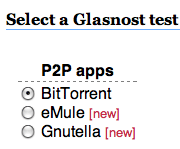Since the explosion of BitTorrent traffic, ISPs have been looking at ways to reduce it in stealth. ISPs like Comcast in USA are infamous for using controversial (and possibly illegal) traffic shaping methods to selectively slow down torrent traffic without touching regular HTTP traffic.
As much as the nature of files shared via torrents maybe, ISPs do not have to actively monitor traffic, and in any case they are not stopping file sharing protocols to stop piracy. Also, there are some legitimate uses of torrents – open-source software (Linux, OOo), files that are permitted to be shared (several indie music artists encourage sharing) etc. In future, legit content distribution systems may also use P2P technology.
ISPs known to limit torrents; Comcast (USA), Bell, Cogeco, Rogers (Canada), BT, Tiscali (UK), City Telecom (Hong Kong), Clearwire (USA), Free (France), Kabel D (Germany), ONO (Spain), TM Net (Malaysia), TVCabo (Portugal), UPC (Netherlands)
The easiest way to detect possible traffic throttling is to compare if there is a large difference HTTP and torrent download speeds (assuming the torrent is healthy and allows maximum bandwidth).
If that is the case, visit Glasnost, a website to test your internet connection for BitTorrent throttling/shaping. It checks upload and download throttling separately, for various protocols and applications.
Being a web application, it is OS-independent, and requires only an internet connection, a web browser and Java (to use Java applet for testing). Mac users have to confirm that you trust the Java applet used to run the test.

If you use BitTorrent (ie. apps like uTorrent, BitComet, Azureus/Vuze, select the BitTorrent test under P2P apps. For other P2P apps like Limewire and Frostwire, select Gnutella (which is the network they run under). The test takes 8 minutes, and should preferrably be run when nothing else utilizes the network, so grab yourselves a coffe and go take a walk while the test runs.
If you see the report as “Your ISP appears to rate limit your downloads/uploads”, throttling is confirmed.